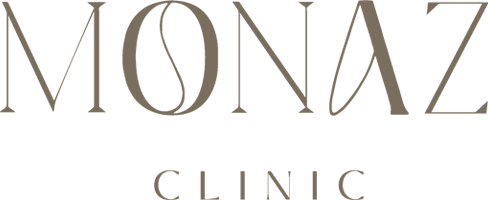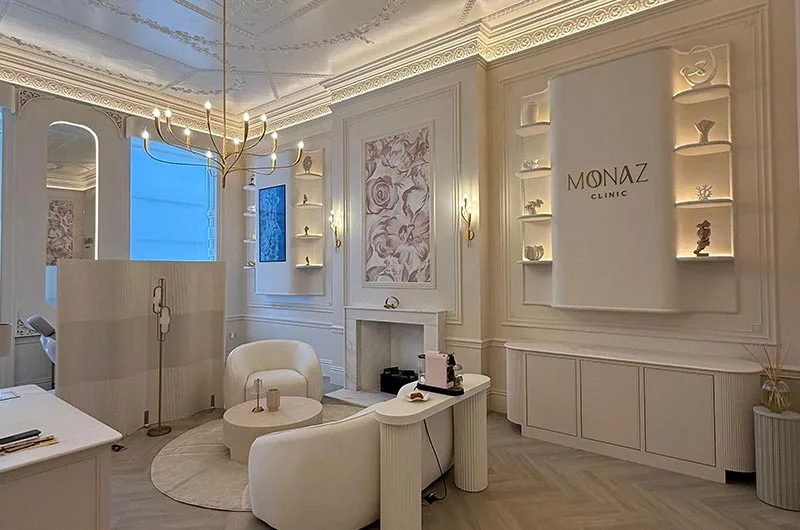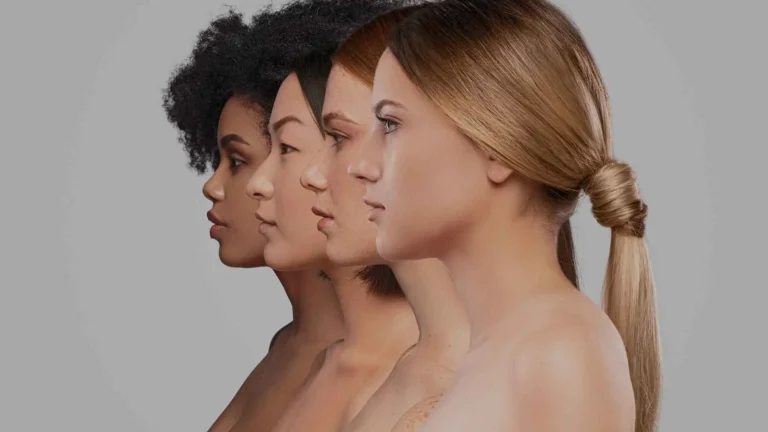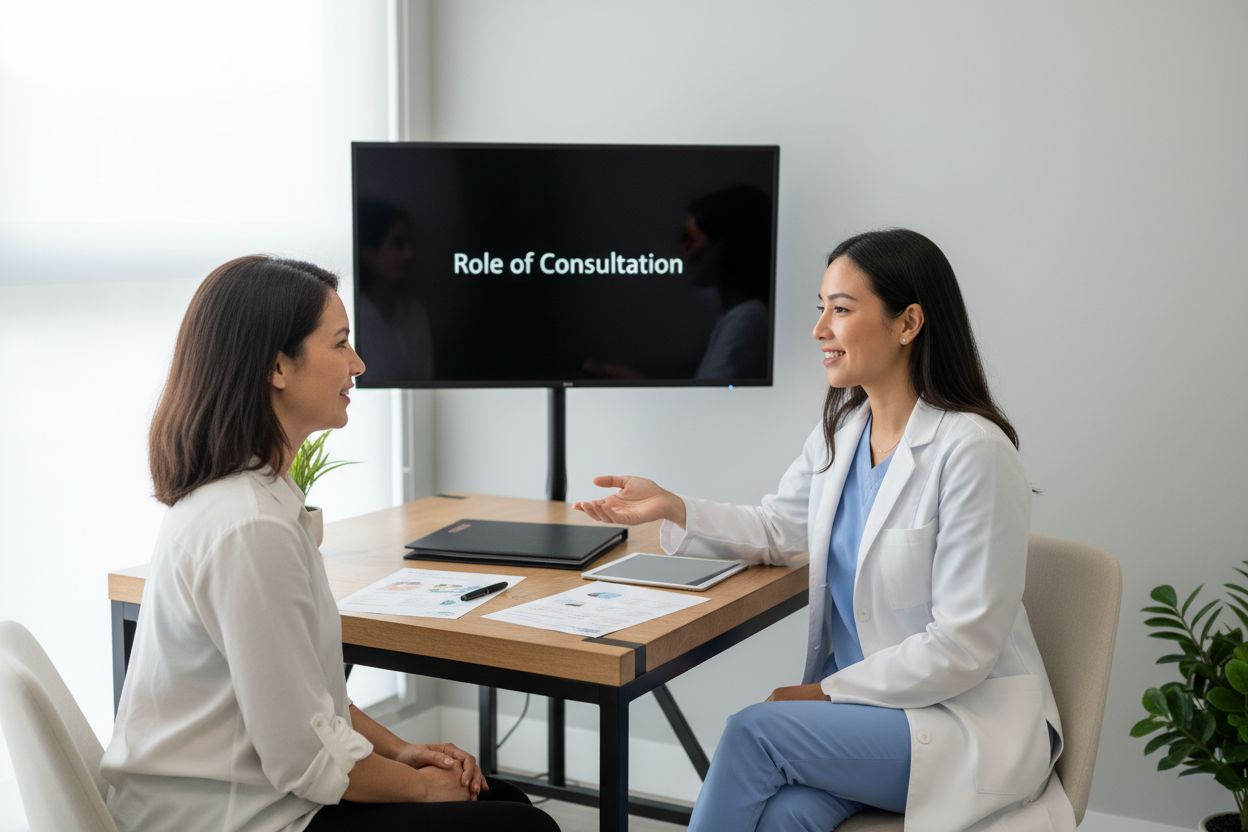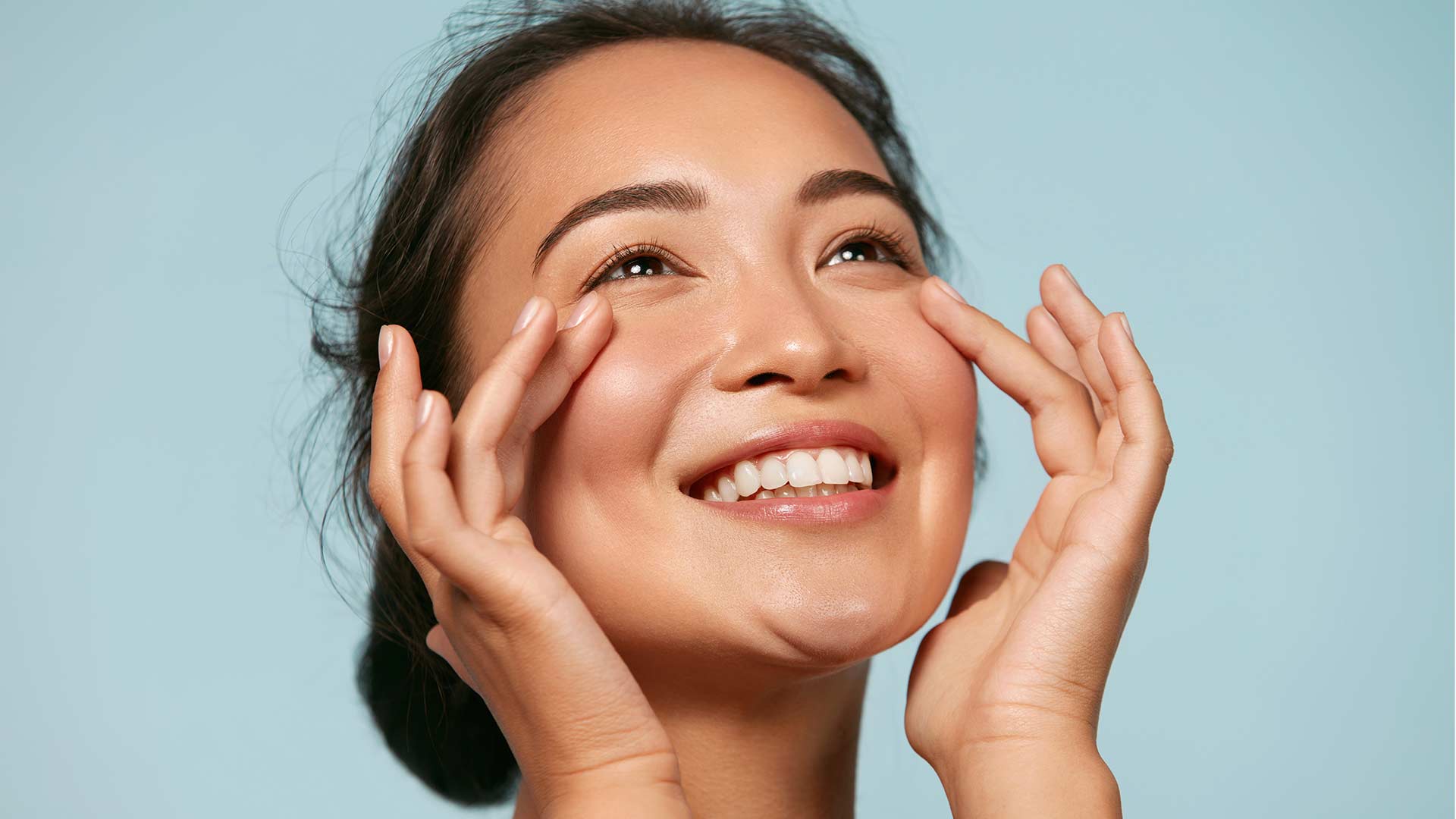Explore the role of consultation in aesthetics for a comprehensive understanding of its importance in achieving desired beauty outcomes.
Thinking of enhancing your appearance with an aesthetic treatment? You might expect the real transformation to happen under the hands of the practitioner in the treatment room. Yet, the part that shapes your entire experience happens much earlier. More than 80 percent of patient satisfaction in cosmetic treatments is linked directly to the quality of the consultation itself. This first meeting sets the stage for everything to follow and may just be the single most important moment in your aesthetic journey.
Table of Contents
- What Is Consultation In Aesthetic Treatments?
- Why Is Consultation Crucial For Aesthetic Decisions?
- How Consultation Enhances Aesthetic Outcomes
- Key Aspects Of An Effective Aesthetic Consultation
Quick Summary
| Takeaway | Explanation |
|---|---|
| Personalised assessment is essential. | Aesthetic consultations involve tailored evaluations to address each patient’s unique needs and goals effectively. |
| Risk identification is crucial for safety. | A thorough review of medical history and skin conditions helps identify any safety concerns before treatment. |
| Manage expectations to avoid disappointment. | Clear communication about potential outcomes ensures patients have realistic views of results and recovery processes. |
| Effective communication builds trust. | Active listening and transparent discussions create a collaborative environment, enhancing patient comfort and decision-making. |
| Advanced diagnostic tools improve results. | Utilising modern technologies allows practitioners to design precise treatment strategies based on individual assessments. |
What is Consultation in Aesthetic Treatments?
A consultation in aesthetic treatments represents a critical preliminary interaction between a patient and a medical professional, serving as the foundational step in understanding individual aesthetic goals and determining appropriate treatment pathways. Unlike standard medical appointments, aesthetic consultations are deeply personalised conversations that explore both physical characteristics and personal aspirations.
The Purpose of Aesthetic Treatment Consultations
Consultations function as comprehensive assessment sessions designed to create a tailored approach to aesthetic interventions. During these meetings, practitioners evaluate multiple aspects beyond surface-level concerns. They analyse facial anatomy, skin condition, medical history, and personal aesthetic objectives to develop nuanced treatment recommendations.
Key objectives of an aesthetic consultation include:
- Understanding the patient’s specific aesthetic concerns
- Conducting a detailed medical and skin health assessment
- Evaluating potential treatment options and their suitability
- Establishing realistic expectations about potential outcomes
- Creating a personalised treatment plan
The Consultation Process and Patient Interaction
A professional consultation involves multiple strategic elements. Practitioners engage in detailed discussions, utilising advanced diagnostic tools and visual assessments to provide comprehensive insights. Understanding the intricacies of aesthetic treatments requires a holistic approach that considers physical, psychological, and emotional dimensions of patient care.
At Monaz Clinic, our consultations prioritise patient comfort and transparency. Practitioners take time to explain potential treatments, discuss potential risks, and ensure patients feel fully informed and empowered in their aesthetic journey. Learn more about our personalised aesthetic approach.
Why is Consultation Crucial for Aesthetic Decisions?
Consultation represents far more than a preliminary meeting in aesthetic treatments. It serves as a comprehensive diagnostic and strategic planning process that transforms potential aesthetic interventions from generic procedures into personalised transformation journeys.
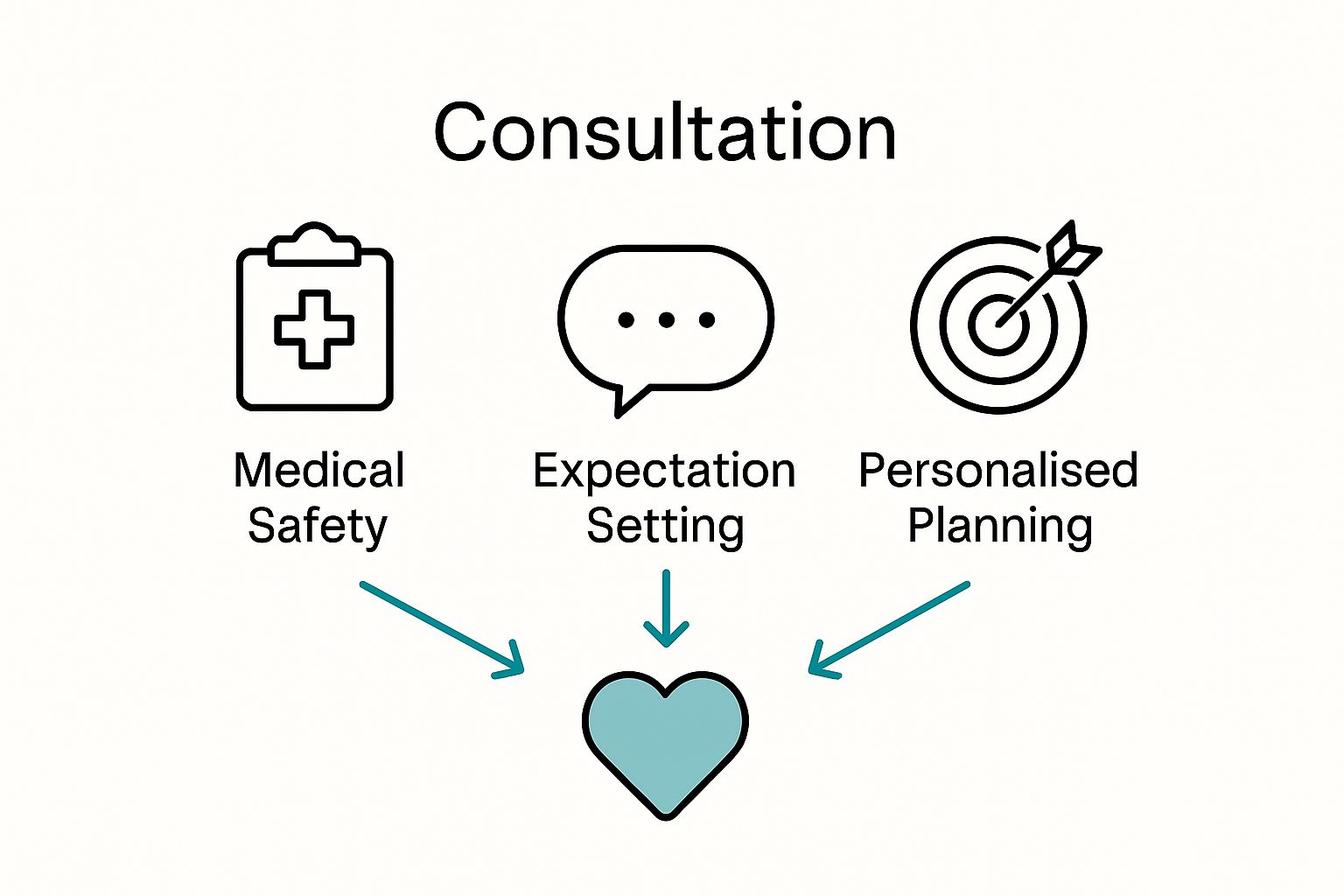 The consultation acts as a critical safeguarding mechanism, ensuring patient safety, setting realistic expectations, and creating tailored treatment approaches.
The consultation acts as a critical safeguarding mechanism, ensuring patient safety, setting realistic expectations, and creating tailored treatment approaches.
Risk Assessment and Patient Safety
Aesthetic consultations are fundamental in identifying potential medical risks and contraindications. Medical professionals thoroughly examine a patient’s complete health profile, including medical history, current medications, skin conditions, and potential allergies. Research from the Royal College of Surgeons indicates that comprehensive pre-treatment assessments significantly reduce complications and enhance patient outcomes.
Key safety considerations during consultations include:
- Identifying underlying health conditions that might impact treatment
- Assessing skin sensitivity and potential allergic reactions
- Understanding patient’s psychological readiness for aesthetic intervention
- Reviewing current medications and potential interaction risks
- Evaluating previous aesthetic or medical treatments
Managing Patient Expectations and Psychological Preparedness
Beyond physical assessment, consultations play a pivotal psychological role. Practitioners help patients develop realistic expectations about potential aesthetic outcomes, preventing potential disappointment or emotional distress. This involves detailed discussions about:
- Potential treatment limitations
- Expected recovery timelines
- Potential side effects and recovery processes
- Long term maintenance requirements
Moreover, consultations provide an opportunity for patients to ask questions, understand procedures in depth, and make informed decisions.
To clarify the different safety considerations and psychological preparedness aspects discussed during aesthetic consultations, the following table presents key elements that practitioners assess and address during this process.
| Aspect | Description |
|---|---|
| Underlying health conditions | Medical history review to discover any conditions affecting safety or suitability for treatment |
| Skin sensitivity and allergies | Assessment of skin type and identification of possible allergic reactions |
| Psychological readiness | Evaluation of patient’s emotional preparedness and understanding of aesthetic change |
| Current medications | Review of all medications to prevent interaction risks |
| Previous aesthetic/medical treatments | Consideration of past procedures and how they may influence outcomes or carry risk |
| Treatment limitations | Clear discussion regarding what the treatment can realistically achieve |
| Recovery expectations | Explanation of likely recovery timeframes and any associated care instructions |
| Long-term maintenance | Dialogue about follow-up treatments or lifestyle modifications to sustain results |
How Consultation Enhances Aesthetic Outcomes
Consultations transform aesthetic treatments from standardised procedures into precision-targeted interventions. By creating a nuanced understanding of individual patient needs, these strategic meetings enable practitioners to design treatment plans that deliver optimal, personalised results. The consultation process acts as a sophisticated diagnostic and planning mechanism that significantly elevates aesthetic treatment effectiveness.
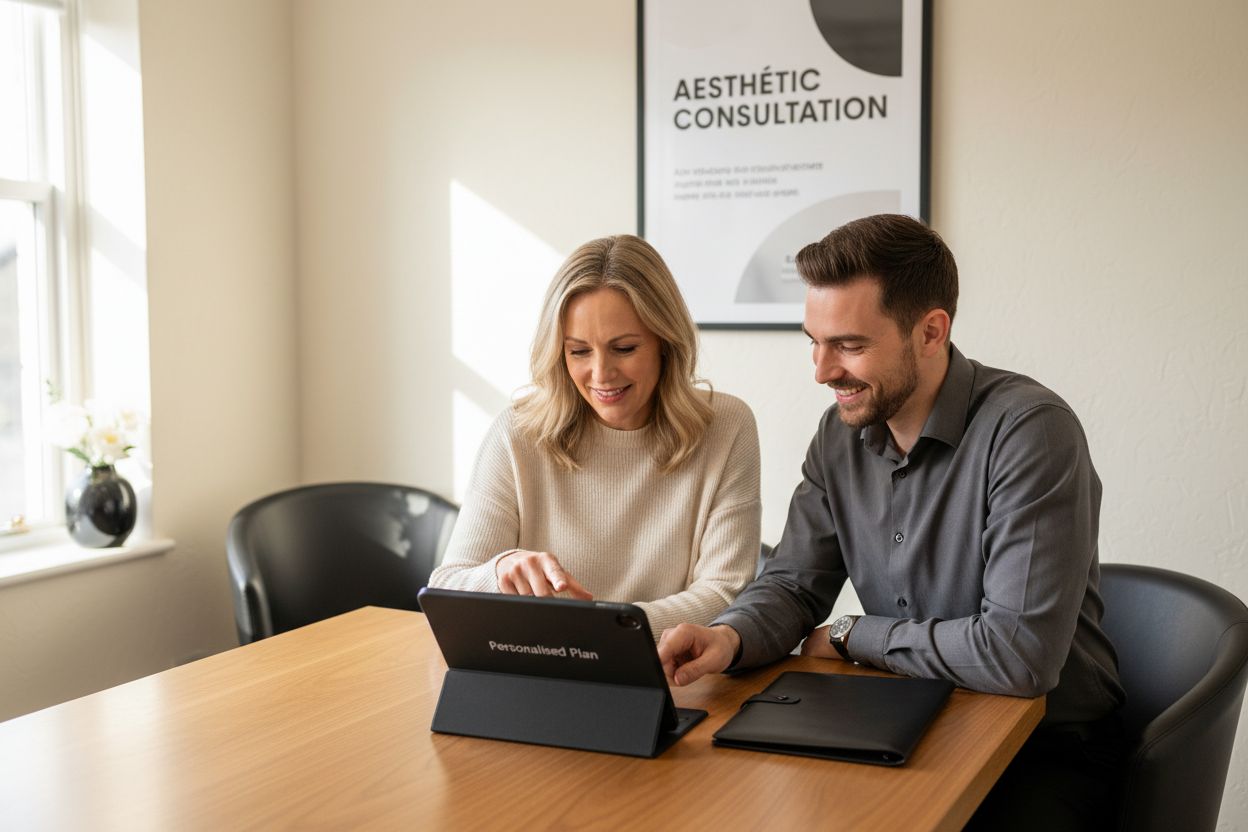
Personalisation and Precision Treatment Planning
Each patient presents unique facial anatomy, skin characteristics, and aesthetic aspirations. Consultations provide an in-depth opportunity to map these individual attributes against potential treatment strategies. Research from the National Library of Medicine demonstrates that individualised treatment protocols dramatically improve patient satisfaction and aesthetic outcomes.
Key elements of precision treatment planning include:
- Detailed facial structure mapping
- Comprehensive skin condition assessment
- Analysis of genetic and lifestyle factors
- Identifying specific aesthetic goals
- Developing customised intervention strategies
Advanced Diagnostic and Treatment Alignment
Modern aesthetic consultations utilise advanced diagnostic technologies to enhance treatment precision.
High-resolution imaging, skin analysis tools, and comprehensive health screenings allow practitioners to develop intricate treatment roadmaps. This technological approach ensures that recommended interventions are scientifically grounded and tailored to each patient’s unique physiological profile.
Beyond technological assessment, consultations create a collaborative environment where patients actively participate in their aesthetic transformation. Our comprehensive guide to facial aesthetic treatments provides additional insights into making informed aesthetic decisions.
Key Aspects of an Effective Aesthetic Consultation
An effective aesthetic consultation transcends mere technical assessment, representing a holistic interaction designed to understand patient motivations, physical characteristics, and potential treatment pathways. These comprehensive meetings blend medical expertise, psychological insight, and personalised communication to create transformative aesthetic experiences.
Communication and Patient Understanding
Successful consultations are fundamentally rooted in high-quality communication. Practitioners must create an environment of trust, actively listening to patient concerns while providing expert guidance. This involves developing a nuanced understanding of both verbal and non-verbal communication signals that reveal patient expectations and emotional readiness for aesthetic interventions.
Essential communication elements include:
- Active and empathetic listening
- Clear explanation of potential procedures
- Transparent discussion of expected outcomes
- Addressing patient anxieties and concerns
- Establishing realistic aesthetic expectations
Comprehensive Assessment Protocols
Effective consultations require systematic and thorough assessment protocols that go beyond superficial evaluation. Research indicates that multidimensional assessment techniques significantly improve treatment precision and patient satisfaction. Medical practitioners must integrate multiple diagnostic approaches to create holistic treatment recommendations.
Key assessment components involve:
- Detailed medical history review
- Comprehensive skin and facial structure analysis
- Evaluation of physiological and psychological factors
- Advanced imaging and diagnostic technologies
- Personalised risk assessment
Moreover, practitioners must maintain a delicate balance between professional expertise and patient autonomy.
The following table summarises essential communication and assessment features that define an effective aesthetic consultation, supporting both practitioner expertise and patient empowerment.
| Key Feature | How It Supports Effective Consultation |
|---|---|
| Active listening | Ensures patient concerns are genuinely understood and addressed |
| Clear procedure explanations | Demystifies treatments, enhancing patient comfort and trust |
| Transparent outcome discussions | Sets realistic expectations and reduces risk of disappointment |
| Addressing anxieties | Helps alleviate fears and encourages open dialogue |
| Thorough medical history review | Identifies safety concerns and personalises care |
| Comprehensive skin/facial analysis | Enables precise diagnosis and tailored treatment planning |
| Advanced diagnostic technology usage | Improves accuracy of recommendations and outcome predictability |
| Personalised risk assessment | Customises the approach for individual physiology and risk factors |
Ready to Start Your Facial Aesthetic Journey with Confidence?
Navigating the world of facial aesthetics can be daunting when you are unsure about the consultation process or worried about feeling pressured or misunderstood. The article highlighted the importance of a thorough aesthetic consultation in setting realistic expectations, ensuring safety, and creating a personalised treatment plan. If you wish to feel truly listened to and supported every step of the way, look no further. Our expert team at Monaz Clinic is dedicated to helping you achieve natural, beautiful results with care and compassion. If you want practical guidance before your first visit, we also invite you to explore our tips for facial aesthetic success.
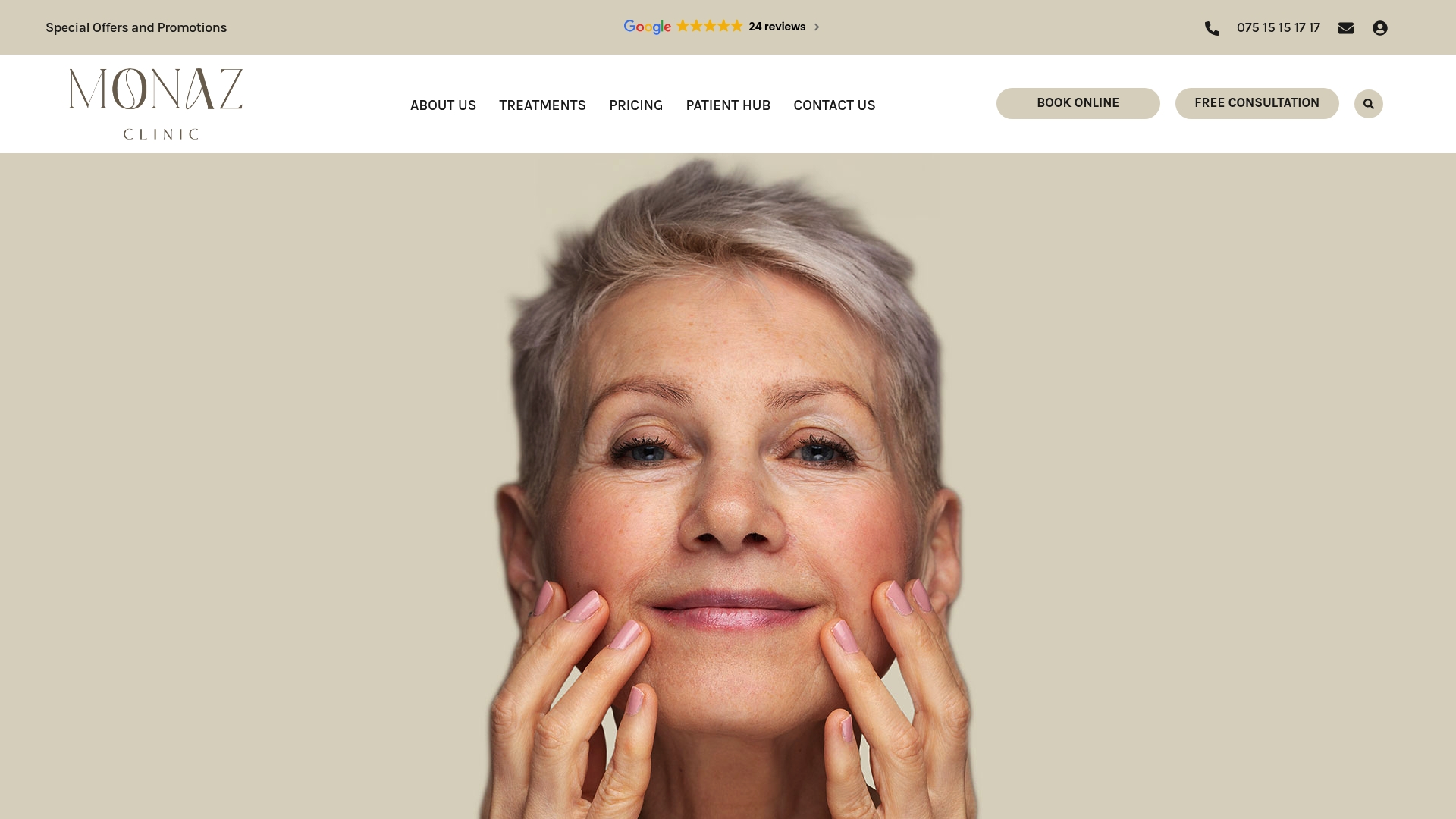
Take control of your aesthetic journey now. Book your complimentary, obligation-free consultation at Monaz Clinic and let us help you reveal your best self. Visit Monaz Clinic today and see the difference that truly personalised care can make.
Frequently Asked Questions
What is the primary purpose of a consultation in aesthetics?
The primary purpose of a consultation in aesthetics is to understand a patient’s individual goals and devise a tailored treatment plan. Schedule your consultation to discuss your specific aesthetic concerns and receive personalised recommendations.
How can a consultation help manage my expectations for aesthetic treatments?
A consultation helps clarify what outcomes are realistic for your chosen treatments by discussing potential limitations and recovery processes. Prepare a list of questions to address during your consultation regarding expected results and timelines.
What should I expect during an aesthetic consultation?
During an aesthetic consultation, you can expect a thorough assessment of your medical history, skin condition, and aesthetic goals. Arrive ready to share your concerns and any previous treatments you’ve had to enhance the discussion.
How does the consultation process improve the safety of aesthetic treatments?
The consultation process improves safety by identifying potential risks, such as underlying health conditions or allergies, before a treatment is undertaken. Make sure to provide your practitioner with a complete health profile, including current medications and medical history.
Why is a personalised treatment plan crucial after a consultation?
A personalised treatment plan is crucial as it aligns recommended interventions with your unique anatomy and aesthetic desires, maximising satisfaction and results. Discuss your goals clearly during your consultation to ensure your treatment plan meets your expectations.
What role does communication play in an effective aesthetic consultation?
Communication is key in an effective aesthetic consultation, as it establishes trust and ensures your concerns are heard and addressed. Focus on open dialogue with your practitioner to fully understand procedures and express any anxieties before proceeding.
